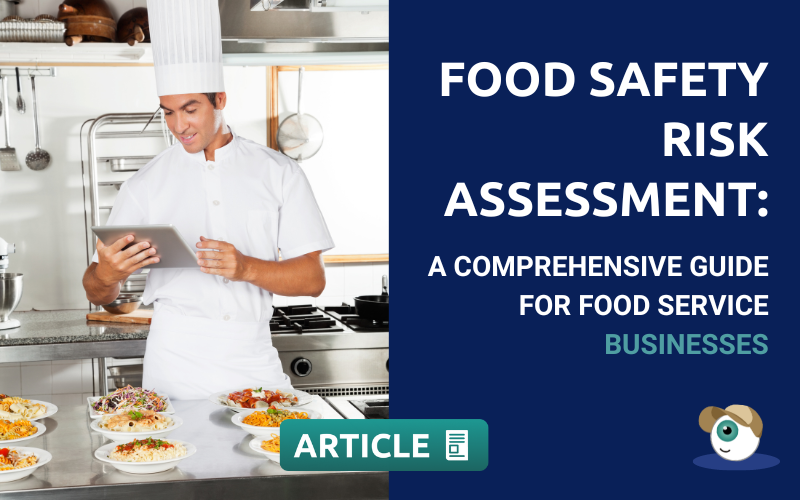Food Safety Risk Assessments: A Comprehensive Guide

Needless to say, foodborne illnesses can have devastating consequences for both consumers and food service businesses, leading to health crises, financial losses, and serious damages to their reputation.
A comprehensive food safety risk assessment is a proactive tool that helps identify, evaluate, and control potential hazards, safeguarding the health of your customers and the sustainability of your operation.
The goal of this article is to provide you with a step-by-step process for conducting a thorough food safety risk assessment to equip you to identify and mitigate potential hazards, ensuring the safety and quality of your food products.
What is a Food Safety Risk Assessment?
A food safety risk assessment is a systematic process of evaluating the likelihood and severity of food safety hazards occurring in your business. It involves identifying potential risks, assessing their significance, and implementing effective control measures to prevent them.
Conducting a food safety risk assessment is not just a legal requirement; it’s a critical investment in the long-term success of your business.
By proactively identifying and addressing risks, you can:
- Protect public health: Prevent foodborne illnesses and protect the well-being of your consumers.
- Maintain regulatory compliance: Ensure that your business meets all relevant food safety standards and regulations.
- Enhance brand reputation: Build trust with your customers and demonstrate your commitment to food safety.
- Reduce financial losses: Minimise the potential for product recalls, legal issues, and damage to your business’s reputation.
Identify Hazards: A Critical Step in Food Safety Risk Assessment
Types of Hazards
When conducting a food safety risk assessment, it’s essential to consider the three primary types of hazards:
- Biological Hazards: These include microorganisms such as bacteria, viruses, and parasites that can contaminate food and cause illness. Examples of biological hazards include:
- E. coli
- Salmonella
- Listeria monocytogenes
- Staphylococcus aureus
- Norovirus
- Chemical Hazards: These are contaminants that can be introduced into food through various sources, including:
- Cleaning agents
- Pesticides
- Allergens
- Naturally occurring toxins
- Physical Hazards: These are foreign objects that can accidentally find their way into food, such as:
- Glass shards
- Metal fragments
- Stones
- Insects
Examples of Hazards in Food Production
To illustrate these types of hazards, let’s consider some real-world examples:
- Biological hazards: A food processing facility may be at risk of contamination from E. coli if proper hygiene practices are not followed.
- Chemical hazards: The use of improper cleaning agents can lead to chemical contamination of food.
- Physical hazards: A piece of broken glass from a shattered window could accidentally fall into a food product.
Assessing Risks: Quantifying the Threat
Once you’ve identified potential hazards, the next step is to assess their risks. This involves evaluating both the likelihood of the hazard occurring and the severity of its consequences if it does.
Risk Analysis Methods
There are several methods for conducting risk analysis, including:
- Risk Matrix: A simple tool that assigns a numerical value to both the likelihood and severity of a hazard, allowing you to prioritise risks based on their overall score.
- Decision Trees: A more complex method that involves analyzing different decision points and their potential outcomes.
- Fault Tree Analysis: A top-down approach that identifies the causes of a potential failure and evaluates their likelihood.
Evaluation Criteria
When assessing risks, consider the following criteria:
- Frequency: How often is the hazard likely to occur?
- Severity: How severe are the potential consequences of the hazard?
- Vulnerability: How susceptible is your business to the hazard?
Example Risk Assessment
Let’s say you’ve identified E. coli as a potential biological hazard in your food production facility. You might assess the risk as follows:
- Likelihood: High, as E. coli is a common foodborne pathogen.
- Severity: High, as E. coli can cause severe illness and even death.
- Vulnerability: High, if your facility has poor hygiene practices or inadequate sanitation measures.
Based on this assessment, you would prioritise E. coli as a high-risk hazard and implement effective control measures to prevent its occurrence.
Implementing Control Measures
Once you’ve identified and assessed risks, it’s time to implement effective control measures to prevent hazards from occurring.
Preventive Measures
Here are some general preventive measures you can take to reduce the risk of food safety hazards:
- Good Hygiene Practices: Ensure that all employees follow proper hygiene practices, including handwashing, hairnets, and clean clothing.
- Proper Food Handling: Store, prepare, and cook food according to recommended guidelines.
- Temperature Control: Maintain proper temperatures for hot and cold foods.
- Sanitation: Regularly clean and sanitize food contact surfaces, equipment, and utensils.
- Pest Control: Implement effective pest control measures to prevent contamination.
Critical Control Points (CCPs)
CCPs are specific points in the food production process where a hazard can be prevented, eliminated, or reduced to an acceptable level. To identify CCPs, conduct a thorough hazard analysis and determine where critical control measures can be implemented.
Monitoring and Verification
- Regular Monitoring: Monitor CCPs on a regular basis to ensure that they are being controlled effectively.
- Record-keeping: Maintain accurate records of monitoring activities, including dates, times, and results.
- Corrective Actions: If a CCP is not under control, take immediate corrective actions to address the issue.
Example CCPs
Here are some examples of CCPs in a food production facility:
- Cooking temperature: Ensuring that food is cooked to the appropriate temperature to kill harmful pathogens.
- Cooling time: Ensuring that cooked food is cooled rapidly to prevent bacterial growth.
- Sanitation of equipment: Verifying that equipment is properly cleaned and sanitized.
Monitor and Review: Ensuring Ongoing Food Safety
To maintain a robust food safety system, it’s essential to continuously monitor and review your risk assessment process.
Continuous Monitoring
- Regular checks: Conduct regular checks of CCPs and other critical control points to ensure they are being effectively controlled.
- Record-keeping: Maintain accurate records of monitoring activities, including dates, times, and results.
- Corrective actions: If you identify deviations from established limits or procedures, take immediate corrective actions to address the issue.
Periodic Review and Adjustment
- Regular review: Conduct periodic reviews of your risk assessment process to ensure it remains effective.
- Updates: Update your risk assessment as needed to reflect changes in your business, processes, or regulations.
- Evaluation of effectiveness: Evaluate the effectiveness of your control measures and make adjustments as necessary.
Challenges in Food Safety Risk Assessment
Despite best efforts, businesses may encounter challenges in conducting food safety risk assessments. Common challenges include:
- Resource limitations: Lack of time, staff, or financial resources.
- Staff training: Inadequate training or knowledge of food safety principles.
- Record-keeping: Difficulty in maintaining accurate and complete records.
- Changing regulations: Keeping up with evolving food safety regulations.
Overcoming Challenges
To overcome these challenges, consider the following strategies:
- Invest in training: Provide your staff with the necessary training to understand and implement food safety practices.
- Implement technological solutions: Consider using food safety software to streamline recordkeeping and monitoring processes.
- Seek external assistance: If needed, consult with food safety experts or regulatory agencies for guidance and support.
Minimising and managing food safety risks with Andy🧢
Andy, the leading food safety and operational excellence digital assistant, can significantly streamline your food safety risk assessment and management processes.
 Here’s how:
Here’s how:
Regular Internal Audits
- Automated schedulling: Andy can schedule and remind you of your internal audit requirements, ensuring that they are conducted at the appropriate frequency.
- Digital checklists: Andy can provide you with customisable checklists to guide your internal audits, ensuring that all critical areas are evaluated.
- Data analysis: Andy can analyse audit results and identify trends to help you pinpoint areas for improvement.
Digital HACCP
- Hazard identification: Andy can help you identify potential hazards in your food production process, based on your specific operations and ingredients.
- CCP monitoring: Andy can track and monitor your critical control points, alerting you to any deviations from established limits.
- Documentation: Andy can automatically generate and store necessary documentation, such as HACCP plans, monitoring records, and corrective actions.
Food Labelling Capabilities
- Allergen management: Andy can help you manage allergen information and ensure accurate labelling.
- Secondary expiry dates: Andy can help you manage secondary expiry dates ensuring that the food that you open and consume in your kitchen is always edible.
- Traceability: Andy can help you track the origin and journey of your ingredients, making it easier to identify and address any issues.
- Supply chain management: Andy can assist in managing your supply chain, ensuring that all suppliers comply with food safety standards and that your products are not contaminated with allergens or other hazards.
- Batch tracking: Andy can help you track specific batches of products, making it easier to identify and isolate any affected items in case of a recall.
By leveraging Andy’s capabilities, you can:
- Reduce the risk of foodborne illnesses.
- Optimise operational efficiency.
- Ensure regulatory compliance.
- Enhance your brand reputation.
Food safety is a critical aspect of any food business. By conducting regular food safety risk assessments and implementing effective control measures, you can protect the health of your customers and the sustainability of your operation.
Andy can be your invaluable partner in this journey, providing the tools and insights you need to ensure food safety excellence.
Ready to try Andy?
👉🏽START YOUR FREE TRIAL TODAY! 👈🏽


